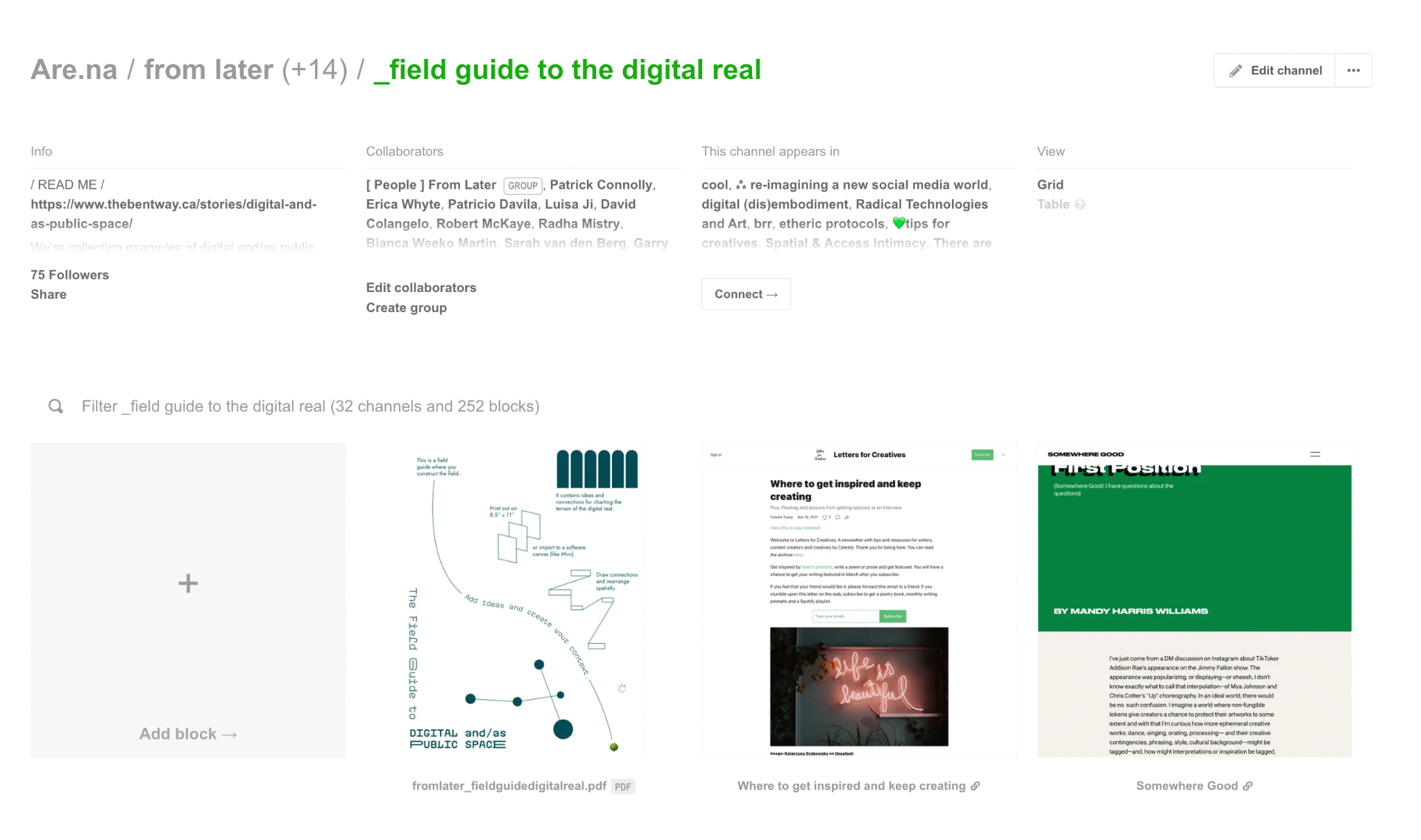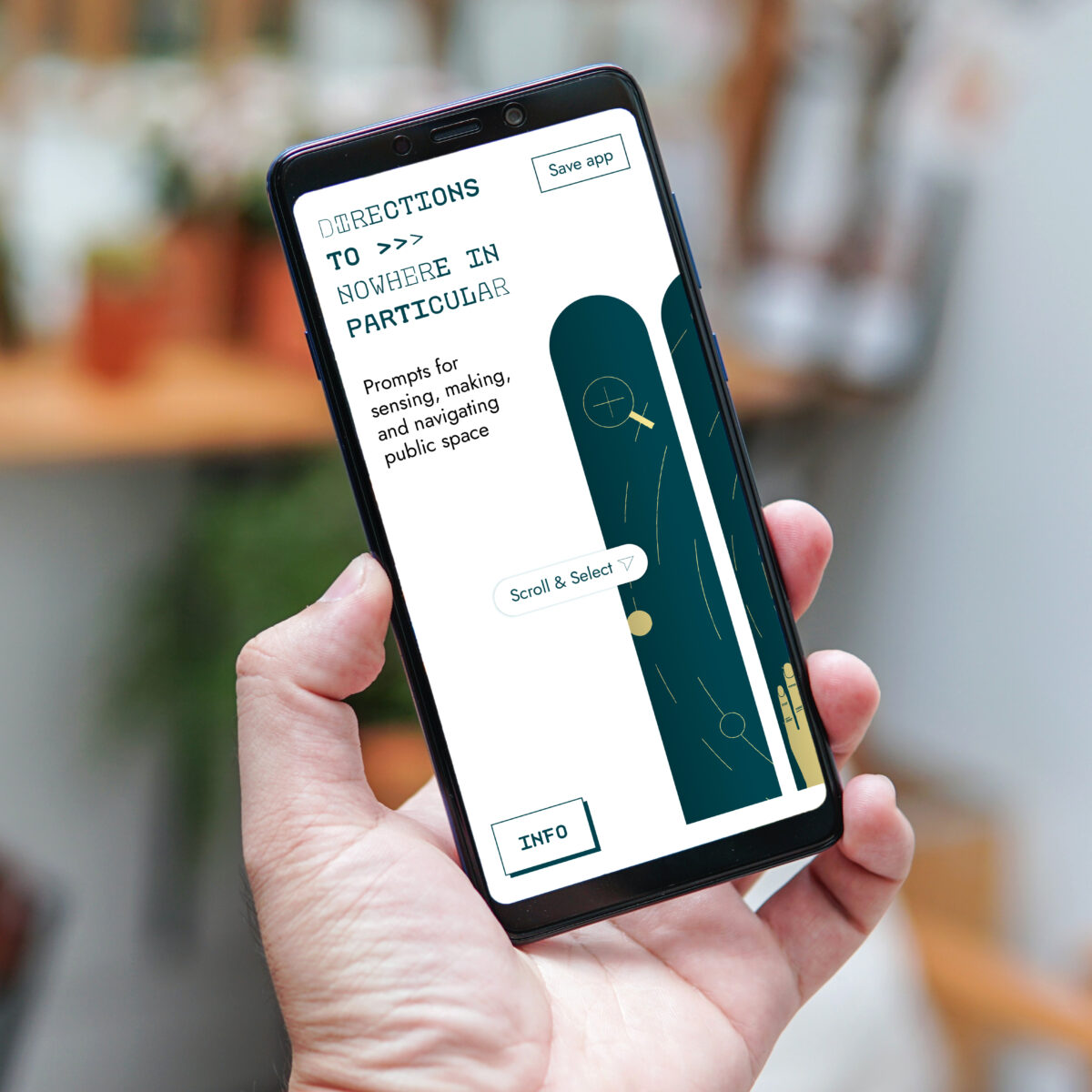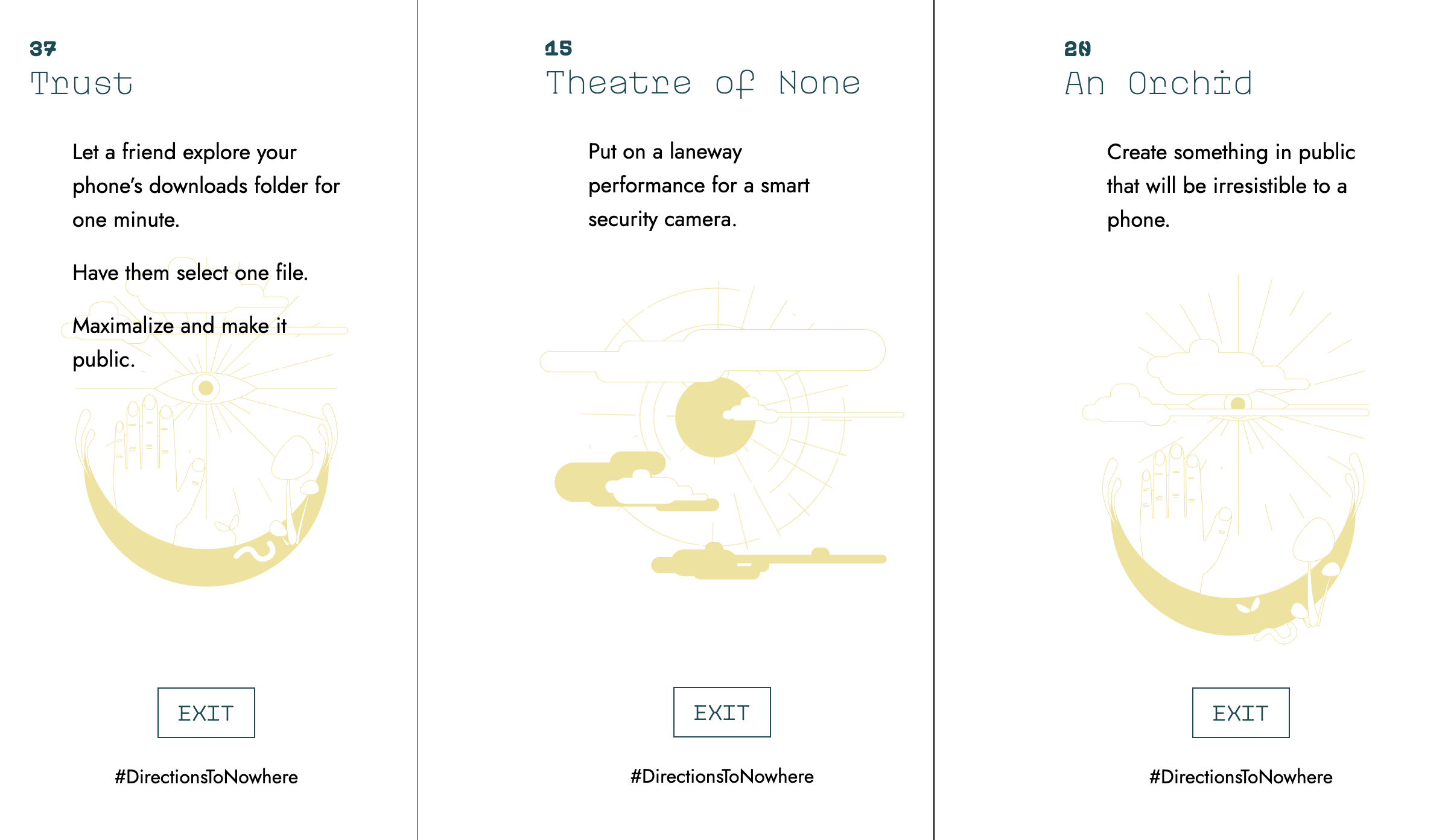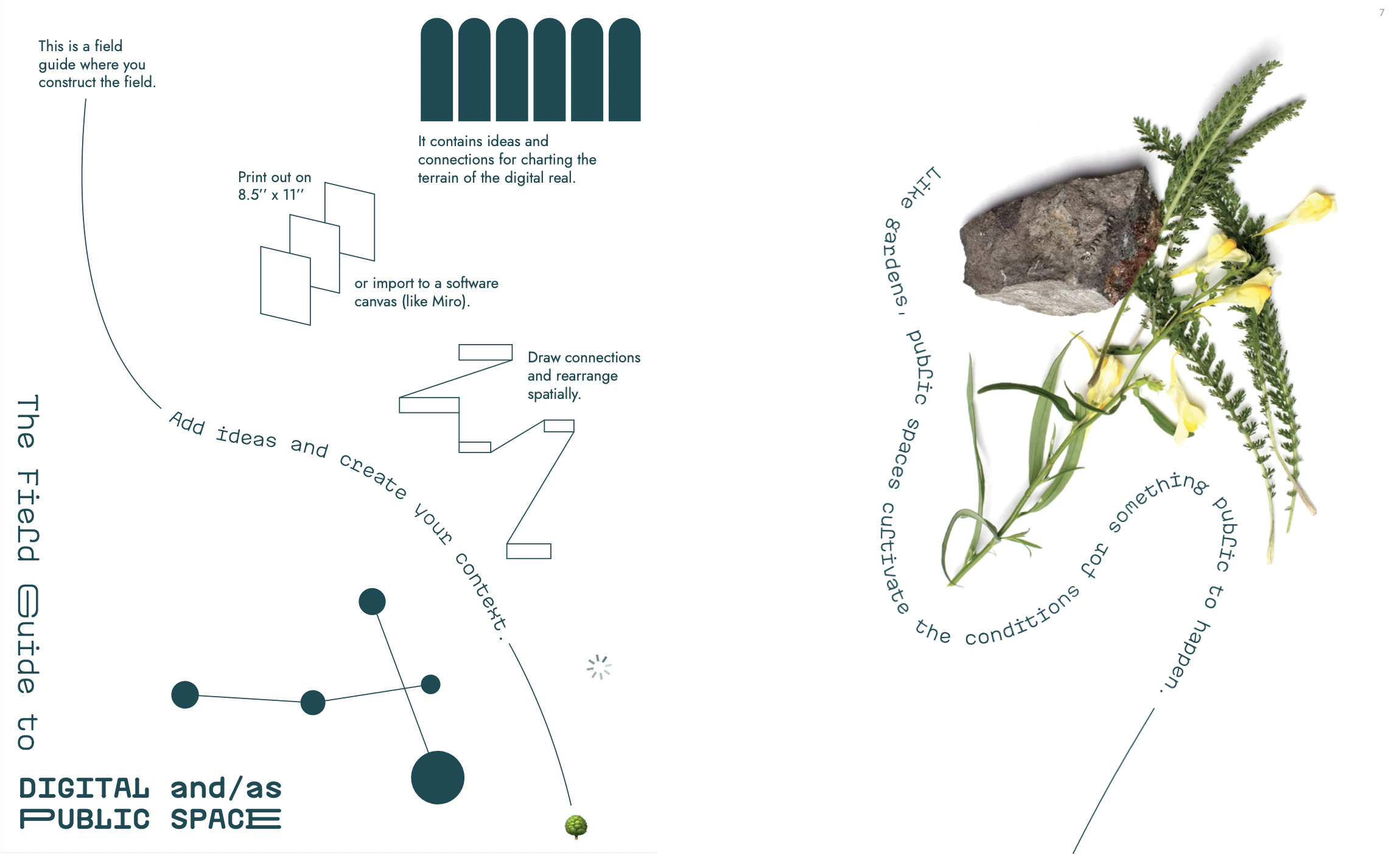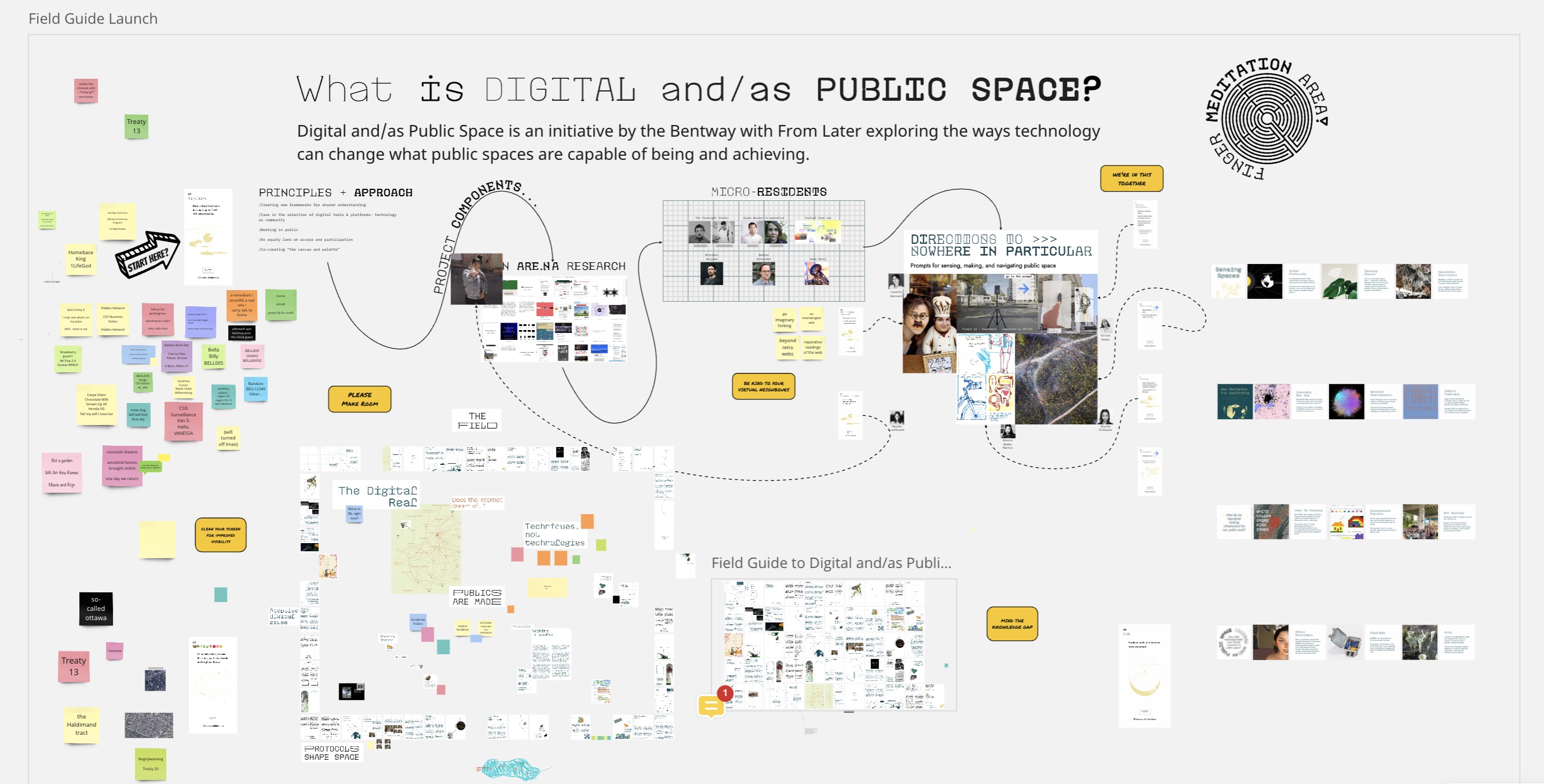Digital and/as Public Space
In response to the COVID lockdowns of 2020 The Bentway, a non-profit land conservancy managing 10 acres of public space reclaimed under a highway in downtown Toronto, temporarily went remote. What would digital technologies mean for such a site-specific organization? What could public space be or become?
A year later, in 2021, From Later partnered with The Bentway to engage in several months of research-creation on the intersection of digital and public spaces. Two outputs emerged: an experimental urban-scale game, Directions to Nowhere in Particular, and a constructible report, A Field Guide to the Digital Real.
Borderlands between the digital and the physical
Pre-digital prompts, field reports, digital gardens, soft reuse, low media
The Bentway, 250 Fort York Blvd, Toronto, ON
I. Altman, R. McKaye, K. Gladki, D. Kay
R. Bolton, M. Siu, V. Silins, U. Vira, J. Glenn, E. Whyte
S. Ducros & R. Thomas, G. Ing & D. Walker, N. Schneider & L. Miller, R. Seraj, M. Akiyama, virtual care lab, OFFICE, L.L. McCarthy, K. Oduro, I. Burrington, M. Lashbrook, H. Tam, D. Crombie, C. Bernard, A. Alikpala, A. Creba, Hyphen Labs, B. W. Martin, J. Stein, M. B. Fleming, V. Rosas, W. Dorner
Nomadic Labs (L. Ji, S. Kennedy)
V. Silins
Approach
How will digital technologies affect public space? Should we think of digital technologies "hybridizing" with the IRL? Is it possible to move the concept of public space online? Are there "digital public spaces"? Are there parallels between site-specificity and (web)site-specificty? Can online spaces be adaptively reused?
These questions opened several months of exploratory research-creation with the Bentway, raising questions that might inform inventive long-term digital strategies. Not answers, necessarily, but questions that could set up useful problems.
Instead of another "futures of" project, with its off-the-shelf methods (scan, sensemake, scenario), we took a more experimental approach. Rather than using off-the-shelf methods, we gradually constructed a method to suit the problem we were discovering. We built the method as we went.
Doing that involved iterating several parallel streams of work. We researched in public, constructed a public game, and held public events. The streams shaped each other over time. Instead of a linear approach, we created a field of interference patterns that helped us experiment our way through the field of digital and/as public space.
Digital Gardens
In kicking off the project we opened a research channel on are.na and encouraged others to add files, thoughts, and links. The channel was a micro experiment. It asked: under what conditions can collaborative dynamics between strangers online emerge? Who would add to the channel and why? Why would anyone participate? What do we offer in return?
It was an experiment in the conditions of a minimally public event. What would happen when a site with a minimal set of mysterious instructions appeared online, and anyone could contribute? Everyone knows the issue with moderation online. We didn’t know how it was going to unfold.
A number of individuals we didn't know, often pseuodnyms, participated. Sometimes strange artifacts would emerge – photos of birds along the Ottawa canal, added by someone who appeared to work for the Armed Services. We don't know why... Maybe something with the word "digital garden" triggered a unique interpretation. Other individuals added material that reflected their ongoing research projects and concerns.
Mostly it was just us.
We were reminded that the biggest challenge in research is not necessarily collecting interesting material. It's not about how weak your signals are or how many you have. It's the coherence that flashes together a constellation of references in a single gesture. That's hard enough for one person to achieve. As Deleuze & Guattari opened their collaboratively written A Thousand Plateaus:
Since each of us was several, there was already quite a crowd.
Sometimes an individual is more distributed than a crowd.
The way individuals linked to our material and interwove it into the tapestry that is Are.na was maybe the most interesting experience. Each individual's channel is like an externalized mind. Seeing who added us and why made us wonder about the fabric of ideas that binds together this moment.
As of 2023, the channel is still active, but it's mostly individuals following or adding links to their channels.
Directions to Nowhere in Particular
At the same time, we designed an urban game of chance, available as a browser-based application. The game proposed randomly suggested prompts – sometimes abstract or cryptic, sometimes straightforward and populist – that redirected users to the troubled borders of the digital and the urban.
With the right conditions and situations, we hoped it could trigger a process of perceiving, conceiving, and enacting public space differently.
The point wasn't to pass along pre-made insights about digital or public spaces. It was to set in motion a process of creation. Do whatever you want – most likely, ignore the prompt. But maybe a question would come back to you on the bus, in a park, in a laneway or alley. Maybe you would just explore that question virtually rather than actually.
The game abstained from the usual imperative voice taken by people working on futures: that some X is transforming some Y. That digital technologies are transforming public spaces, or something like that.
What mattered for us were less technologies than techniques. We were interested in how people go about constructing the ways in which publics come into being. We didn't want to predict that, but offer tools that could be turned into people's own creative techniques.
Rather than imagining possible futures, it was more interesting to let people experiment with what they already had present, but whose limits weren't yet known.
That made aesthetic precursors more interesting to us than the futurist preference for description. We wanted to feel and experiment with the future, not picture and discuss it.
Here's a list of some of those who inspired that more aesthetic approach:
/ Oblique Strategies by Brian Eno and Peter Schmidt
/ Randonautica and other astrological low media
/ Kenneth Goldsmith and conceptual writing
/ Tino Sehgal and relational aesthetics
/ Surveillance Camera Players, Electronic Disturbance Theater, and other tactical media
/ Psychogeography and the situationists
First prompt responders
We commisioned a number of friends and acquiantances to repond to a prompt and make the results publically available, in some form. Some chose to combine prompts and create their own. The responses were an pivotal part of the experiment-friendly research we hoped would emerge, and helped shaped a number of the ideas documented in the field guide.
Thank you:
/ OFFICE
/ Lauren Lee McCarthy
/ Kofi Oduro
/ Ingrid Burrington
/ Mayumi Lashbrook
/ Howard Tam
/ David Crombie
/ Colette Bernard
/ Alyssa Alikpala
/ Alison Creba
/ Hyphen Labs
/ Bianca Weeko Martin
/ Julian Stein
/ Marcus Brittain Fleming
/ Vivian Rosas
/ Willi Dorner
Below are a handful of selections.
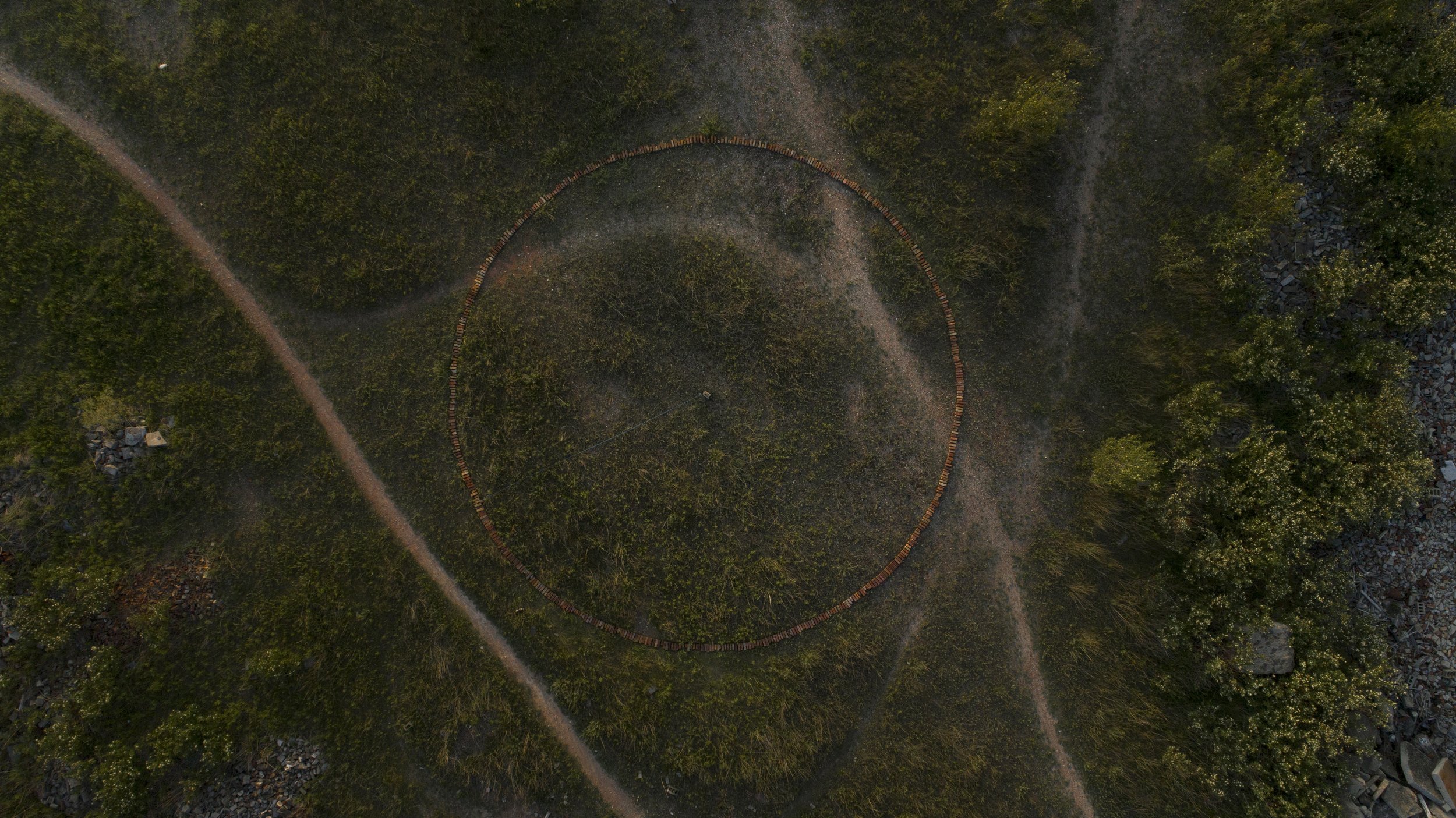 Alyssa Alikpala responded to a prompt to "make something visible from space." The result was a giant perfect circle of bricks made on a reclaimed piece of land which juts out several kilometers into Lake Ontario: the Leslie Spit, at whose end is Thommy Thompson Park. The Spit is constructed from the waste of skyscrapers and other building materials of Toronto. Alikpala's circle was built through several days of scavenging bricks and aligning them by GPS and drone. In 2022, the circle was visible from Google Earth's landsat imagery.
Alyssa Alikpala responded to a prompt to "make something visible from space." The result was a giant perfect circle of bricks made on a reclaimed piece of land which juts out several kilometers into Lake Ontario: the Leslie Spit, at whose end is Thommy Thompson Park. The Spit is constructed from the waste of skyscrapers and other building materials of Toronto. Alikpala's circle was built through several days of scavenging bricks and aligning them by GPS and drone. In 2022, the circle was visible from Google Earth's landsat imagery.
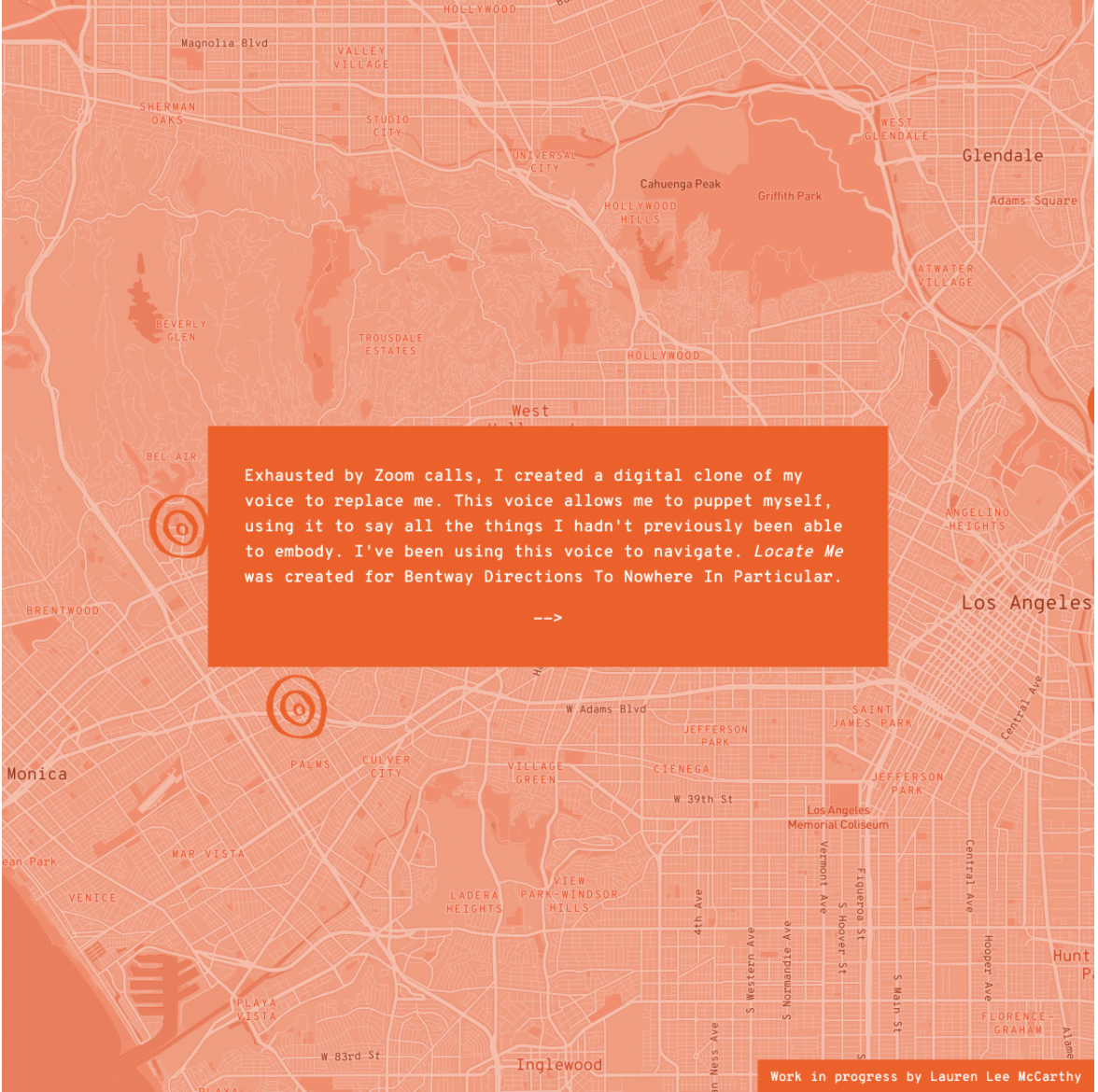 Lauren Lee McCarthy responded on the basis of a prompt called "Automation: Choose another prompt. Get Siri, Alexa, or another virtual assistant to help you execute it." Instead of following the prompt to the letter, McCarthy created a digital clone of her own voice – raising questions around the gendering of voice assistants, the ethics of always listening devices, the blur of private and public, data doppelgangers and uncanny self-reflections, and the affective atmospheres produced by voice interfaces.
Lauren Lee McCarthy responded on the basis of a prompt called "Automation: Choose another prompt. Get Siri, Alexa, or another virtual assistant to help you execute it." Instead of following the prompt to the letter, McCarthy created a digital clone of her own voice – raising questions around the gendering of voice assistants, the ethics of always listening devices, the blur of private and public, data doppelgangers and uncanny self-reflections, and the affective atmospheres produced by voice interfaces.
Melbourne-based design studio OFFICE responded to a prompt that simply said: "broadcast the soundscape." Following noise complaints from local residents in 2016, a downtown area of Melbourne was redeveloped to prevent skateboarders from using the space, which had been one of the city's most iconic locations. OFFICE responded to the prompt by recording the sound of skateboarders in another part of the city, and broadcasting it by speaker back into the banned area – re-instituing a contest over the use of public space through a (not immediately obviously) digital technique.
Field Guide to the Digital Real
The streams of work and experiments fed into the creation of a research report. We framed it around the idea of a field guide. However, every field guide needs a field. What was our field? Something that didn't yet exist.
We twisted around the field guide's typical function: to catalogue and identify already-existing entities.
This would be a field guide for creation, not identification. For launching new techniques into the borderlands of the digital and the real. It wouldn't speak in the imperative voice, and it wouldn't identify in the categorical.
It just sought to catalzye – here are a few ideas, terms, and experiments from others that you might use to invent your own meaning of digital and/as public space. We'll try to provide it with some sense, but the rest is up to you.
It was designed in a format that could be read straight through, but could also be rearranged.
It could be imported into Miro or another digital whiteboard and reordered, or cheaply printed onto A4 and moved around, using the affordances of paper-based media – to literally grasp and move information around with your hands.
Design cues like snaking lines could let pages be connected to other pages, like a jigsaw puzzle or mosaic. Admittedly, like lots of experiments, we didn't much experiment with this after creating it.
Micro-residencies
Documented in the field guide but commissioned before it are the micro-residencies we held with researchers and artists.
We shared early ideas and themes we had for the report with the residents, but otherwise let them interpret the ideas as they wanted. They were free to use the time and resources to build something they might have already had on the backburner, but given a new energy or angle.
The ways they worked through their mini-projects were critical to the development of the field guide.
Thank you:
/ Sady Ducros & Richard Thomas (The Foresight Studio)
/ Garry Ing & Dawn Walker (Hypha Worker Co-operative)
/ Nathan Schneider & Luke Miller
/ Raad Seraj
/ Mitchell Akiyama
/ virtual care lab (Alice Zhang, Sara Suárez, Lea Rose Sebastianis)
Below are two projects, shown here as illustration. All of the projects are documented in the field guide.
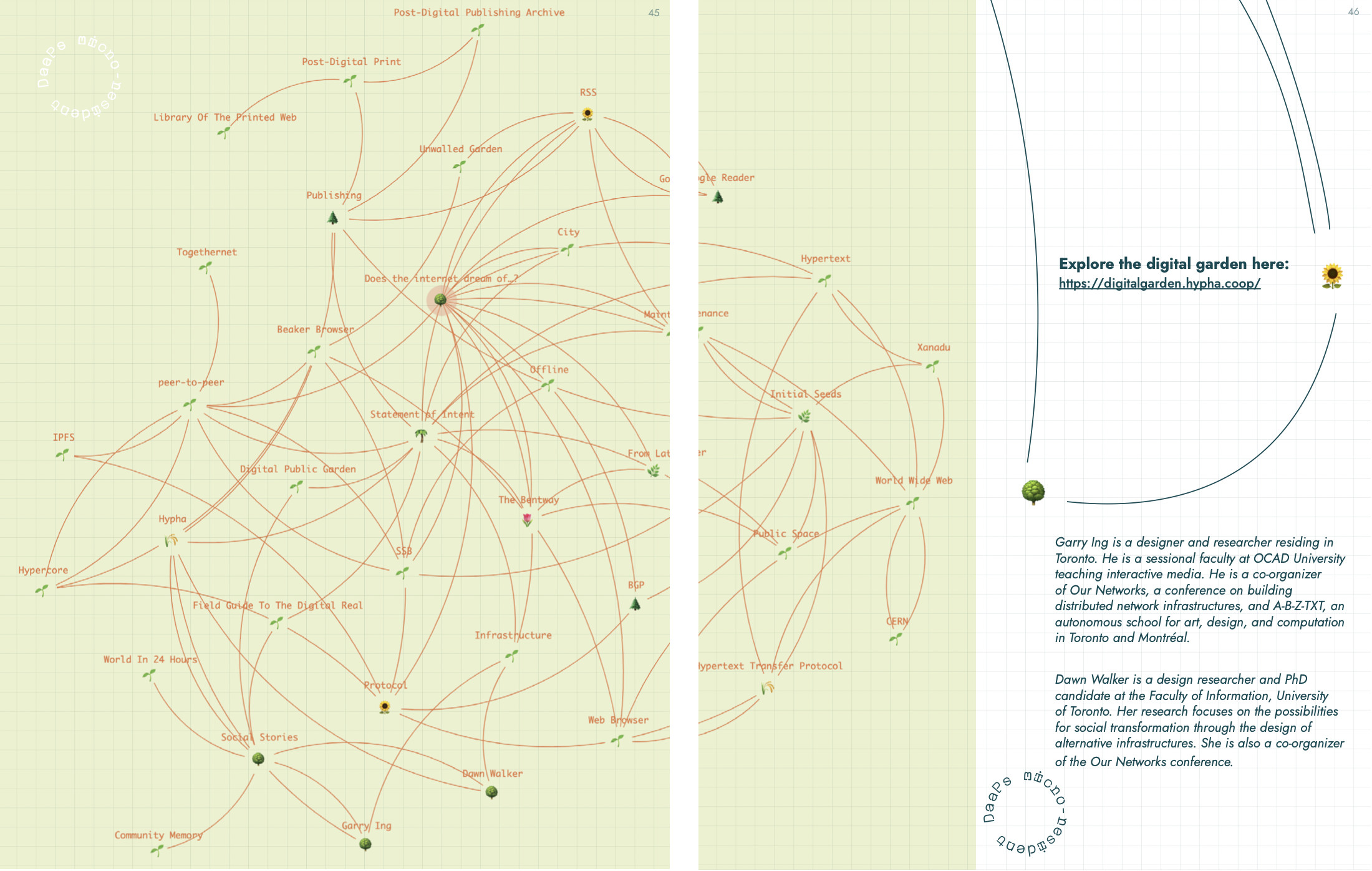 Garry Ing and Dawn Walker constructed a hand-coded digital garden of terms relating to open source movements, and their interconnections. The code, which uses Jekyll to construct a static site, is available on Github under a GPL-3.0 license for others to use. You could fork and create your own. The site – which maps the past to enact possible futures – is accessible here.
Garry Ing and Dawn Walker constructed a hand-coded digital garden of terms relating to open source movements, and their interconnections. The code, which uses Jekyll to construct a static site, is available on Github under a GPL-3.0 license for others to use. You could fork and create your own. The site – which maps the past to enact possible futures – is accessible here.
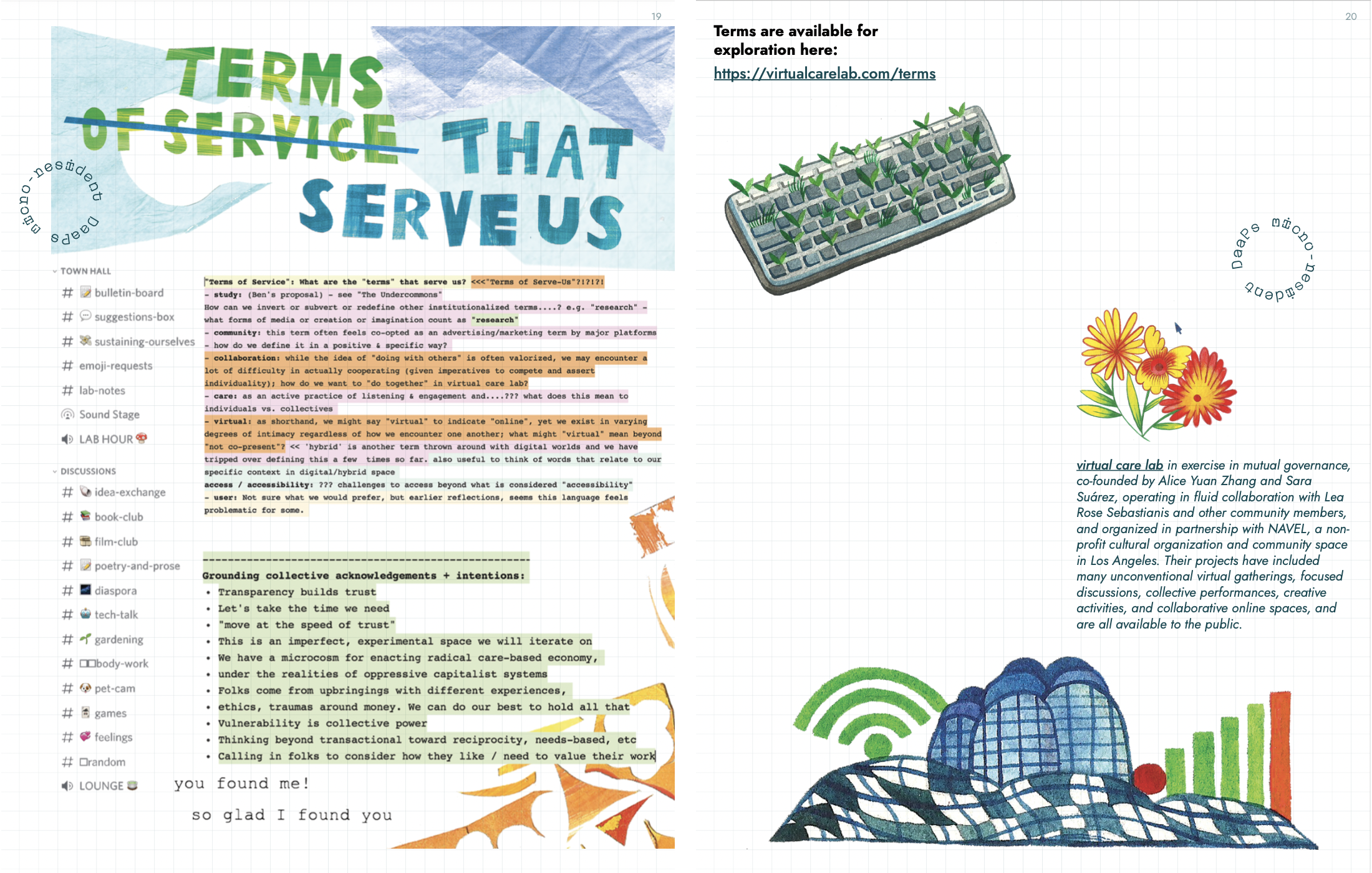 Residents from virtual care lab – Alice Zhang, Sara Suárez, Lea Rose Sebastianis – held weekly online gatherings to reflect on community governance. That process ended up initiating a participatory writing experiment called Terms that Serve Us, which temporarily repurposed Google docs to use as a meeting place and community tool. The terms – which are inventions not images – are accessible here.
Residents from virtual care lab – Alice Zhang, Sara Suárez, Lea Rose Sebastianis – held weekly online gatherings to reflect on community governance. That process ended up initiating a participatory writing experiment called Terms that Serve Us, which temporarily repurposed Google docs to use as a meeting place and community tool. The terms – which are inventions not images – are accessible here.
The process of taking ideas (like digital gardens, or adaptive digital reuse, in the two above examples) and turning them into something concrete always reveals there is something more to it than what you first imagined. There are points of friction that emerge when you make an idea concrete. You realize it doesn't quite work how you thought it did – that other parts of reality, not compressed by your idea, actually affect and shape it. That causes the idea to expand in unexpected ways.
Having microresidents experiment with ideas we borrowed or invented revealed angles that merely imagining at our desks would never have surfaced.
Collective Sensemaking
Everyone knows project launches and panels are mostly there to be grinned and beared. You hope the participants will at least be less bored than you, but it's by no means guaranteed. Ours was no different.
We tried, however, to introduce a few participatory elements to make it more interesting for everyone.
We created an open Miro board that anyone with a link (provided during the launch) could visit. Elements were not locked or controlled, so it was free to be rearranged by anyone in the audience. That was, after all, the point of the field guide. To be rearranged. We tried to introduce an element of chance to challenge ourselves, to make it more interesting and spontaneous than just speaking in the expected ways.
Which, to be fair, is mostly what it became anyway.
Like a school dance, participants waited at the edges. Glances were exchanged, messages sent across the floor, but interactions mostly remained still. An energized situation never broke out. At the same time, at the edges, movement did happen. Things did take place, beyond our perception; it always does.
Perhaps with another launch we'll figure out the right elements of chaos to make more adventurous activity. It might just be hard to build an affective atmosphere over a tool like Zoom, which largely prevents people from talking over each other. It's hard to feel like a crowd.
The Miro board for the launch is still available here. Yesterday an anonymous visitor even came by and changed the board in some microscopic way (a year and a half after the launch).
Reflections
As a foresight studio, it's expected we make "images of the future." But sometimes – maybe often – representations of the future are not quite futuristic enough. What you need is something more experimental, conceptual, aesthetic. Less denotative, didactic, representational.
After we launched this project, we received puzzled looks from some of those familiar with our studio: "But I thought you worked on futures stuff?"
But for our team, it was obvious that this was a futuristic project. Others expected it to be set in the future, to be about the future. But we saw these experiments as revealing something about what was possible, rather than just imagining it. That led to one of us presenting the project at Primer 2022.
When futures took up design in the last decade, it largely relegated it to illustration: to make better representations of the future, or more immersive and tangible experiences. But design has more inventive elements – to create new mechanisms, capacities, and affordances. That comes about through a more experimental process, one that reveals that the present contains more potential than what we realized of it. The present is wider than the possibilities we imagine of it, and that discovery comes about through experimentation.
We hope this project is some small way pushed in that direction – to more formally experimental, inventive methods. Pictures of the future are fine, but sometimes you have to push at the bounds of the form to get somewhere new.
Additional Thanks
To all of the invidiuals and groups that checked-in, edited, or consulted in the process (but are not necessarily responsible for any views/content in this study):
Melissa Johns, Ashley Jane Lewis, Gabe Sawhney, J. Soto, Mitchell F. Chan, Niki Little, Patricio Davila, Jen Zielinska, Sam Redston, Salome Asega, EYEBEAM, imagiNative, iNdigital Youth Collective...
And anyone who's reached out to chat or had thoughts after!
Thank you especially to The Bentway for supporting a project that may have at times been productively stranger than anticipated.


